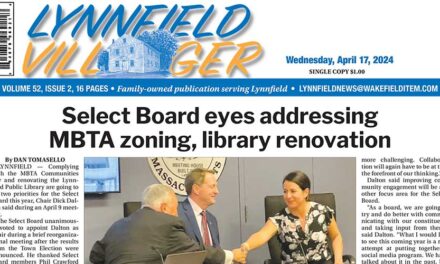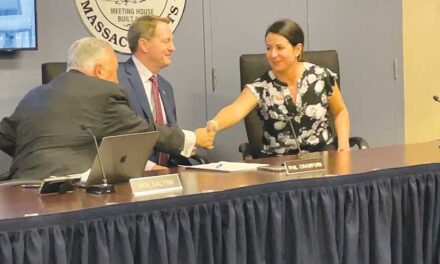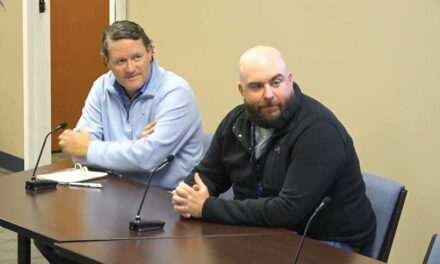Published February 5, 2020
By DAN TOMASELLO
LYNNFIELD — Changes are coming to the Lynnfield Center Water District’s rate structure.
The LCWD Board of Water Commissioners held an informational workshop about the proposed rate changes in front of a sparsely attended crowd in the Al Merritt Center on Monday. Most of the people in attendance were LCWD officials.
Superintendent John Scenna said the district currently collects revenue from two different areas that are located in two different bills.
“You are accustomed to getting a bill in July with a $60 fee,” said Scenna. “That is a lump sum. You also get an additional bill in December for the water you consumed that year. What some of you don’t know is there is a second component of how we collect our revenue, and that is through real estate tax bills.”
Scenna said the LCWD receives 17 percent of its revenue through water rates, while 77 percent comes from real estate tax bills. Six percent of the revenue comes from other sources.
“What we have been discussing for quite some time is this the most sustainable and equitable way to price out the true cost of water,” said Scenna.
David Fox, who works for consulting firm Raftellis, recalled that he has been working with Scenna, the water commissioners and the Rate Setting Committee as part of the process of overhauling LCWD’s rates.
“The purpose of the rate study and going through this process was to determine if there was a better way to recover revenue for the district,” said Fox. “We wanted to make sure that we are generating enough money through water rates and taxes to ensure operations are sustained today and into the future.”
Fox said one of the commissioners’ priorities was to “promote equity among the customer base.” He also said the water commissioners want the district to have “revenue stability” and wants to ensure that the LCWD has “adequate revenues” in order to fully fund necessary investments that will be needed to maintain the water system.
Scenna noted the LCWD is currently undertaking a study that is looking to address the discolored water issues that have impacted residents living near the North Reading line. He also said the study is looking to identify ways to provide supplemental water.
Fox said the first proposed rate change involves having the LCWD start issuing bills quarterly instead of biannually.
“Quarterly billing will bring you in line with the vast majority of other water utilities in New England,” said Fox. “Instead of getting one bill per year, customers will now get four bills a year. Customers will receive a lower bill every three months instead of paying one bill once a year.”
Fox said the LCWD currently uses a 10-tier rate structure for ratepayers, which he said is “an anomaly in the water industry.”
“We wanted to reduce the number of tiers in order to simplify the rate structure,” said Fox.
Fox said the LCWD has proposed reducing the number of tiers from 10 to three. If ratepayers use between zero and 24,000 gallons of water per quarter, Fox said ratepayers will pay $6.45 per thousand gallons.
“The typical household in the district uses about 15,000 gallons per quarter,” said Fox.
If customers use between 25,000 and 36,000 gallons of water per quarter, Fox said they will pay $16.13 per thousand gallons. If ratepayers use over 36,000 gallons of water per quarter, he said they will pay $19.35 per thousand gallons.
“This will start again at the end of every quarter,” said Fox. “Once three months go by, you will start at zero.”
In addition to the volumetric rate changes, Fox said customers will be paying a $25 fee each quarter. He said non-residential customers will pay a $50 fee each quarter.
Fox also noted that the town will be charged $2.10 per thousand gallons of water used each quarter. He said the town will pay a $25 fee each quarter.
“There is less cost associated with serving municipal customers,” said Fox.
Fox said ratepayers who have homes with a “high assessed value” but don’t consume a lot of water “are going to benefit from this change.”
“It brings equity into the system,” said Fox. “Just because you live in a very expensive home and you are not using a lot of water, you are now paying, in my opinion, more than your fair share for water service. You are not placing that much of a demand on the system as opposed to someone who lives in a modest home who is using a lot of water.”
As part of the existing rate structure, Fox said ratepayers are paying on average $800 per year for water.
“About $700 from that is coming from taxes and about $100 is coming from rates,” said Fox. “Under the new system, the same typical customer is going to see that their bill is going to be unchanged. It will be staying about $800.”
Fox also said the new rate system will allow customers to “control their bill more.”
“If they use less water, they are going to pay less,” said Fox. “That is not really the case right now.”
Fox said non-residential customers, which are identified as “other” as part of the new rate structure, “are going to pay more under this system.”
“These typical customers are going from about $908 to a little over $1,000 under this new system,” said Fox.
Fox said, “Well over 50 percent of customers under this new system will actually see no change at all in their bill or will actually see a reduction in their bill.”
“There will be some customers that are going to see an increase,” said Fox.
Water Commissioner Rob Almy, who worked as the manager of the Santa Barbara County Water Agency from 1990 through 2008 and has also worked as a consultant in the water industry, expressed his support for the proposed rate changes.
“What is being proposed here is in fact in line with what I have seen in other areas,” said Almy. “The costs are comparable and the need for cost recovery for a water district in order to maintain its reliable service to its customers is paramount.”
Scenna said the water commissioners will be voting on the proposed new rate structure during the board’s next meeting on Monday, Feb. 10, which will take place in the Summer Street School all-purpose room at 7 p.m.
“Public participation is encouraged,” said Scenna. “We would welcome any and all feedback.”
If the water commissioners approve the rate changes, Scenna said ratepayers will receive a final bill under the former payment system in March.
“You will receive one last bill in March for the water you have used in December, January and February,” said Scenna. “That bill will be calculated under the existing rate. On March 1, the water that you consume will be subject to new rates. Those new rates will be billed quarterly moving forward.”
Scenna said ratepayers will be receiving bills in June for water consumed in March, April and May. He said ratepayers will be billed in September for the water consumed in June, July and August. Scenna said ratepayers will receive bills in December for the water used during September, October and November.
In response to a question from LCWD Secretary Stefan Taschner, Scenna said the changes to the district’s tax levy will take place in fiscal year 2021.
“The tax levy will be reduced in the late fall of this year,” said Scenna.
Scenna noted Lynnfield Media Studios filmed the workshop and the meeting has been posted on https://vimeo.com/user36270762.




